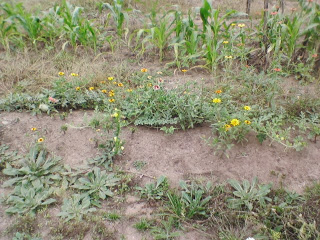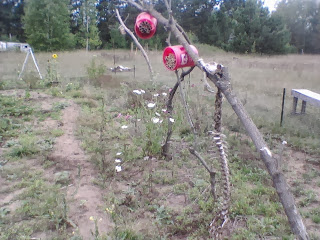Wow, this blog still exists. I apologize for dropping off the face of the Earth for so long. I was so disheartened by some losses and failures that I completely missed out on chronicling my journey to becoming a "real" farmer. It did happen eventually, just not the way I imagined it.
My dreams of becoming a vegetable farmer were more or less dashed after that last season I wrote about here. By 2014 the weeds became overwhelming in my lazy no-till scheme (I still whole-heartedly believe no-till can work, just not the way I was doing it). The need for soil improvement was (and still is) so great and it's hard to know where to even start. What happened is I gave up on trying to be a "real" farmer and eventually I became a seed farmer of native wildflowers and medicinal herbs. I started a food forest with drought tolerant native fruit and nut species and improved my pollinator habitat. I started making salves and tinctures with the plants in my yard--including the weeds! Last year I started experimenting with ecoprinting and botanical dyeing, which yielded some fruitful results!
I also returned to school since my last post. My thesis research is on the sand cherry, Prunus pumila, and its pollination biology. I have struggled with finding a rewarding career that pays enough while living in a rural area, so I hope that improving my education will assist me with that. I feel lucky and blessed to be getting paid to go to school (yay STEM fields!) and to have that guaranteed income at a time when so many people are struggling or out of work. I hope to graduate at the end of this year and then start a new career in the spring of 2022. I really want that 2-3 months off in between to a) replenish my adrenal system after all this crazy stress and b) spend some time turning all my beautiful plant-dyed fabrics and yarns into cool stuff I can sell.
I also started a family since my last post. I am so excited to try gardening with my kid this year. I made some new beds by piling peat, compost, and straw on top of cardboard and we planted some cover crops and cold weather crops in them. Nothing has come up yet, so we may need to try again. I took an inventory of my seeds and discovered I have way too many of them. I have begun to transfer them from my closet to other growers so they don't just die here. It's a difficult process, deciding which ones I'll actually plant someday and which ones are better off in someone else's care. I have some cool seeds because in 2013 I invested quite a bit in heirloom varieties and I compulsively bought rare seeds when I encountered them. So far a Romanesco broccoli and a Russian kale from 2013 have sprouted with really good germination rates, so I am hopeful for the rest.































